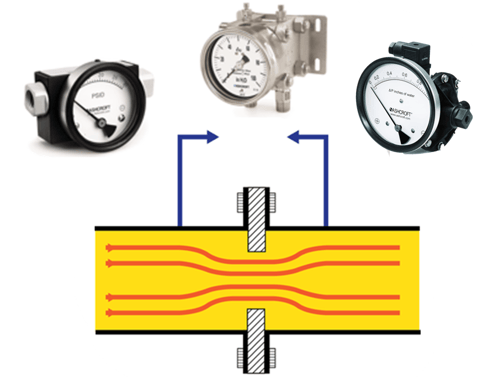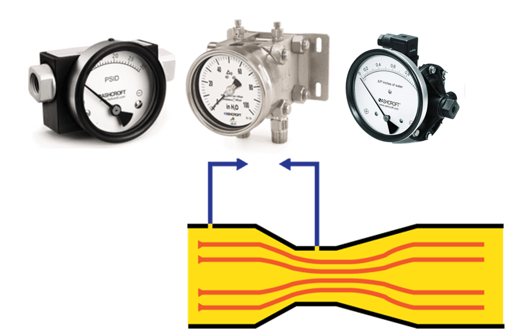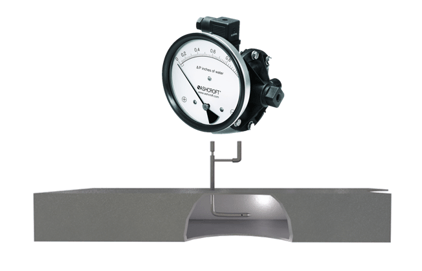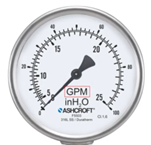
By:
Dave Dlugos
Product Technical Leader
Published on:
December 11th, 2023
Subscribe now and get the latest blog posts delivered straight to your inbox.
Why use a differential pressure gauge to measure flow?

By:
Dave Dlugos
Product Technical Leader
Published on:
December 11th, 2023

If you work in an industry with harsh process environments like oil and gas, water and wastewater and others, you know that liquid and gas flow measurement is critical to ensuring your operation runs safely and efficiently. You also know that purchasing a flow meter to perform this function can cost you thousands of dollars. One popular and very effective alternative is to configure a differential pressure (DP) gauge to measure flow. This simple step can deliver the same results and save you money.
In this article, you will learn the basic concepts of fluid dynamics and pressure distribution based on Bernoulli’s Principle. You will also see why DP gauges are ideal for monitoring flow in harsh environments and how easy it is to configure these instruments to meet your specific needs.
Since 1852, Ashcroft has been an industry leader in measurement instrumentation. As a product marketing leader, I am happy to share information that can help you discover solutions to your complex challenges. When you are finished, you will know how to configure your DP gauge to measure flow and be guided to other helpful resources that can help you find the right DP gauge for the job.
Why do you need to monitor fluid flow?
There are many reasons to monitor fluid flow in your process, including energy efficiency, environmental concerns and operational performance. However, it is primarily done to protect the quality of your product and the safety of people. A slow flow may indicate a clogged line or other issue, while a fast flow may indicate that your check valve is set incorrectly. In any case, flow changes in your process require immediate attention.
Typically, industries like yours invest in expensive flow meters to measure, monitor and control liquid or gas flow through various applications. These meters and transmitters send critical data back to the control system to make changes as required. However, electronic flow meters and transmitters aren’t the only options for managing this task. If the requirement is to only measure and monitor flow, many engineers opt for a less expensive measurement solution using a DP gauge that is based on Bernoulli’s principle.
What is Bernoulli’s principle?
Daniel Bernoulli was an 18th-century Swiss mathematician and physicist who studied fluid dynamics (how liquids and gases move and interact with their surroundings) and pressure distribution. Bernoulli discovered that within a horizontal flow of fluid in a pipe that considers velocity, elevation and other factors, points of higher fluid speed will have less pressure than points of slower speed. In other words, as the speed of a fluid increases, its pressure decreases, and vice versa.
An obstruction in the pipe will accelerate the flow velocity and will create a measurable differential pressure. The flow is linear to the square root of the different pressure.
By measuring the pressure difference before and after the constriction, engineers can accurately determine the flow rate of fluids, such as water or gas, passing through the pipe. This principle finds applications in industries like water supply, chemical processing, air handling and oil and gas.
Three common methods to measure flow using DP gauges.
There are several ways to measure flow with DP gauges. For this article, we will focus on the three most common methods, which are all derived from Bernoulli’s principle:
1. Orifice plate
2. Venturi tube
3. Pitot tube
Keep in mind, while each of these methods will measure and monitor flow, DP gauges are only visual indicators. They do not send information directly to a control system that can adjust flow in the same way that electronic transmitters do.
1. DP gauge flow measure with orifice plates.
The orifice plate is the most commonly used method for flow measurement. It consists of a thin plate with a precisely sized hole or orifice. When placed in the pipeline, the flow through the pipe causes a large drop in differential pressure. The DP gauge is placed across the orifice plate and connected to the pressure taps. As described in Bernoulli’s principle, flow is linear to the square root of the different pressure.
Figure 1: Orifice plate.

2. DP gauge flow measure with venturi tubes.
The venturi effect (caused by a venturi flow meter, aka tube) is also based on Bernoulli's principle. A venturi tube consists of a constricted pipe section that causes the fluid velocity to increase, resulting in a decrease in pressure. The DP gauge is connected to the pressure taps. venturi tubes create less of a differential pressure drop than orifice plates, they are used when an orifice plate might have too much of a restriction for the process-required flow rates.
Figure 2: Venturi tube.

3. DP gauge flow measure with pitot tubes.
For airflow measurement in a heating duct, for example, a pitot tube is commonly used. The main difference between pitot tubes and orifice plates and venturi tubes is that an orifice plate or venturi tube measures the full flow in the pipeline. The pitot tube measures the flow at only one point in the flow stream. Once again, in this method, flow is linear to the square root of the different pressure.
Figure 3: Pitot tube.

How to measure flow using a DP gauge.
Once you decide to use a DP gauge to measure flow in your application and determine which method you plan to use, the next step is to determine the differential pressure that will be produced by the flow rate of the orifice plate, venturi tube or pitot tube. This information should be provided by the manufacturer of the plate or tube.
-
From there, simply do the following:
-
Install the orifice plate, venturi tube or pitot tube into the process piping or air handling ducts.
-
Measure the pressure drop by connecting the DP gauge to pressure taps upstream and downstream of the orifice plate or the high and low-pressure taps on the venturi tube or pitot tube.
-
Calculate the flow rate.
-
Design a flow dial for the DP gauge based on the maximum flow rate and units you desire to display.
Note: if desired, the DP gauge can have a dual range scale to show both flow and DP pressure.
Figure 4: Dual range scale: inches H2O and gallons per minute.

It's also important to note that the accuracy of the flow measurement depends on various factors, including the orifice plate, venturi tube or pitot tub design, fluid properties, installation conditions and calibration requirements. Consulting relevant standards and guidelines is recommended for accurate flow measurement.
Which method will you use to measure flow with your DP gauge?
Now that you have a basic understanding of Bernoulli’s principle, orifice plates, venturi tubes and pitot tubes, you can see how using a DP gauge can serve as an effective and cost-saving alternative for measuring and monitoring flow in your application. Once you select the method and get the required flow rate from the plate or tube manufacturer, the rest is fairly straightforward.
To learn more about factors to consider when selecting a pressure gauge for harsh applications, download our guide. 
Or, if you have questions, feel free to contact one of our industry experts. In the meantime, here are a few other articles that may interest you:
Dave Dlugos, Product Technical Leader
Dave Dlugos has a BSEE degree and 40 years of experience in the measurement industry performing design engineering and product management. He has earned 4 U.S. patents and joined Ashcroft in 2007, currently as the Product Technical Leader. He is a senior member of the International Society of Automation (ISA), past ISA District 1, Vice President, past ISA water and wastewater division board member and the past President of CT Valley ISA Section.


























